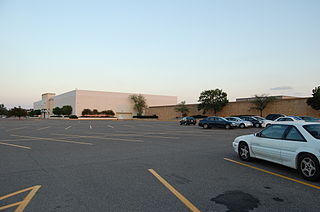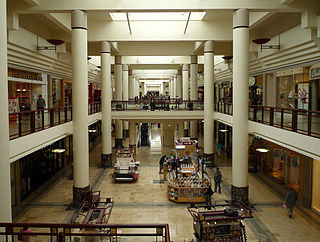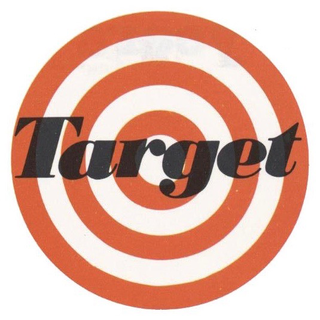
Macy's, Inc. is an American holding company of department stores. Upon its establishment in 1929, Federated held ownership of the regional department store chains Abraham & Straus, Lazarus, Filene's, and Shillito's. Bloomingdale's joined Federated Department Stores the next year. Throughout its early history, frequent acquisitions and divestitures saw the company operate a number of nameplates. In 1994, Federated took over Macy's, the old department store chain originally founded in 1858 by American entrepreneur Rowland Hussey Macy. Despite Federated's long history of preserving regional nameplates, its acquisition of the May Department Stores Company in 2005 marked the end of those nameplates. By the following year, both the Macy's and Bloomingdale's brands had replaced them nationwide. Ultimately, Federated itself was renamed Macy's, Inc. in 2007, an acknowledgment of the old store's venerable name.

Nicollet Mall is a twelve-block portion of Nicollet Avenue running through Downtown Minneapolis, Minnesota, United States. It is a shopping and dining district of the city, and also a pedestrian mall and transit mall. Along with Hennepin Avenue to the west, Nicollet Mall forms the cultural and commercial center of Minneapolis.

Whittier is a neighborhood within the Powderhorn community in the U.S. city of Minneapolis, Minnesota, bounded by Franklin Avenue on the north, Interstate 35W on the east, Lake Street on the south, and Lyndale Avenue on the west. It is known for its many diverse restaurants, coffee shops and Asian markets, especially along Nicollet Avenue. The neighborhood is home to the Minneapolis Institute of Art, the Minneapolis College of Art and Design, and the Children's Theatre Company.
Dayton's was an American department store chain founded in Minneapolis, Minnesota, in 1902 by George Draper Dayton. It operated several local high-end department stores throughout Minnesota and the Upper Midwest for almost 100 years. Although it was regionally known as a high-quality shopping destination, Dayton's is best remembered for starting the discount shopping chain Target. The company was also instrumental in the history of shopping malls, opening the first indoor shopping mall in the United States—Southdale Center in Edina, Minnesota, in 1956.

Southdale Center is a shopping mall located in Edina, Minnesota, a suburb of the Twin Cities. It opened in 1956 and is the first fully enclosed, climate-controlled shopping mall in the United States. Southdale Center has 1,297,608 square feet of leasable retail space, and contains 106 retail tenants. The mall is owned by Simon Property Group and the anchor stores are Macy's, Dave & Buster's, AMC Theatres, Hennepin Service Center, and Life Time Athletic.
P.A. Bergner & Co. is an upscale Midwestern department store in the United States, that was established in 1889. The chain is now an online retailer operated by BrandX.com, Inc. The flagship store was located in Peoria, Illinois at The Shoppes at Grande Prairie.

The Eden Prairie Center is a mall located in Eden Prairie, Minnesota. It has been managed by Jones Lang LaSalle as of 2020. It is anchored by Kohl's, Target, Von Maur and Scheels Sporting Goods.

Associated Dry Goods Corporation (ADG) was a chain of department stores that merged with May Department Stores in 1986. It was founded in 1916 as an association of independent stores called American Dry Goods, based in New York City.
The Powers Department Store of Minneapolis, Minnesota was a department store chain with roots dating to 1873, and that, at its peak, consisted of 7 locations in Minnesota.
Allied Stores was a department store chain in the United States. It was founded in the 1930s as part of a general consolidation in the retail sector by B. E. Puckett. See also Associated Dry Goods. It was the successor to Hahn's Department Stores, a holding company founded in 1928. In 1935 Hahn's was reorganized into Allied Stores.

Burnsville Center is located in Burnsville, Minnesota. It is one of the larger enclosed malls in Minnesota with 100 stores on 3 floors and approximately 1,100,000 square feet (100,000 m2). The mall opened in 1977 with three anchor stores, Sears, Dayton's, and Powers Dry Goods as anchors.
Crossroads Center is a shopping mall in St. Cloud, Minnesota, United States, and is the largest mall in the state outside the core Twin Cities metro area. Its six anchor stores are Macy's, JCPenney, Target, Scheels All Sports, HomeGoods, and DSW Inc. The Marshall Field's store (originally Dayton's was officially renamed Macy's on September 9, 2006.

Wilsons Leather is a U.S. leather brand, selling products such as leather jackets, belts, shoes, handbags, and gloves. At its peak in 2002, the Minneapolis-based retailer had 763 stores in 46 states and Canada. The company stores used to sell product assortments from brands such as DKNY, Michael Kors, Guess?, and Cole Haan.

Ridgedale Center, colloquially known as Ridgedale, is an enclosed shopping mall in Minnetonka, Minnesota, a western suburb of the Twin Cities. It is directly located off I-394/US 12 between Ridgedale Drive and Plymouth Road. Ridgedale Center comprises 1,105,337 square feet (100,000 m2) of leaseable retail space, and contains approximately 140 retail tenants. It is currently jointly owned by Brookfield Properties and CBRE Group, and managed by Brookfield. The anchor stores are JCPenney, Nordstrom, Macy's, and Dick's House of Sport.

Northtown Mall is a shopping mall located in Blaine, Minnesota, United States. The mall's anchor stores are Hobby Lobby, Best Buy Outlet, 2 Becker Furniture World stores, and Burlington. In addition, Northtown Mall features over 100 stores and restaurants, as well as a food court and Paladin Career and Technical High School public charter school which was open in September 2002. The mall is owned by 4th Dimension Properties. Over 5.5 million people visit the mall every year.
Shingle Creek Crossing, formerly Brookdale Center, is a regional shopping mall in Brooklyn Center, Minnesota. It became the third enclosed shopping mall in the Twin Cities, after Southdale Center and Apache Plaza. The mall opened in phases beginning with Phase One in March 1962 which included anchor stores Sears and JCPenney. Phase Two opened in 1966, adding Dayton's as the third anchor. Donaldson's became the fourth anchor in September 1967. Brookdale Center was part of "The Dales", what was referred to as the four "Dale" centers circling the Twin Cities, originally developed by Dayton-Hudson Corporation. The others are Southdale Center in Edina, Rosedale Center in Roseville and Ridgedale Center in Minnetonka. After a long decline, the mall closed in 2010 and was demolished in 2012 before being redeveloped into the Shingle Creek Crossing development.

Rosedale Center, commonly known just as Rosedale, is a shopping center in Roseville, Minnesota. The mall is surrounded by suburbs and close to major highways and serves a trade area population almost 2 million people, and boasts 14 million visitors annually.

Maplewood Mall is a super-regional shopping mall in Maplewood, Minnesota, United States. It is near Interstate 694 on the Saint Paul side of the Twin Cities metropolitan area. Maplewood Mall opened in 1974. It was later renovated and expanded in 1996. It is managed by Washington Prime Group of Columbus, Ohio. The mall's anchor stores are Barnes & Noble, JCPenney, Kohl's, and Macy's with one vacant anchor last occupied by Sears.

The history of Target Corporation first began in 1902 by George Dayton. The company was originally named Goodfellow Dry Goods in June 1902 before being renamed the Dayton's Dry Goods Company in 1903 and later the Dayton Company in 1910. The first Target store opened in Roseville, Minnesota in 1962, while the parent company was renamed the Dayton Corporation in 1967. It became the Dayton-Hudson Corporation after merging with the J.L. Hudson Company in 1969 and held ownership of several department store chains including Dayton's, Hudson's, Marshall Field's, and Mervyn's. In 2000, the Dayton-Hudson Corporation was renamed to Target Corporation.

Minneapolis City Center is a mixed-use shopping mall on Nicollet Mall in Minneapolis, Minnesota. It opened in 1983 and occupies the bottom three floors of the 33 South Sixth office building. Designed by Skidmore, Owings & Merrill, Minneapolis City Center contains 250,000 square feet (23,000 m2) of leasable retail space. The mall was built around the pre-existing Forum Cafeteria restaurant. The building is adjacent to the Marriott Hotel City Center and connected to the Gaviidae Common shopping mall.













